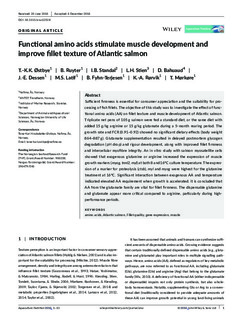| dc.contributor.author | Østbye, Tone-Kari K | |
| dc.contributor.author | Ruyter, Bente | |
| dc.contributor.author | Standal, Inger Beate | |
| dc.contributor.author | Stien, Lars Helge | |
| dc.contributor.author | Bahuaud, Diane | |
| dc.contributor.author | Dessen, Jens-Erik | |
| dc.contributor.author | Latif, Muhammad Saqib | |
| dc.contributor.author | Terjesen, Bendik Fyhn | |
| dc.contributor.author | Rørvik, Kjell-Arne | |
| dc.contributor.author | Mørkøre, Turid | |
| dc.date.accessioned | 2017-11-03T12:35:31Z | |
| dc.date.available | 2017-11-03T12:35:31Z | |
| dc.date.created | 2017-03-21T13:05:16Z | |
| dc.date.issued | 2017-01-30 | |
| dc.identifier.citation | Aquaculture Nutrition. 2017, . | nb_NO |
| dc.identifier.issn | 1353-5773 | |
| dc.identifier.uri | http://hdl.handle.net/11250/2463996 | |
| dc.description.abstract | Sufficient firmness is essential for consumer appreciation and the suitability for processing of fish fillets. The objective of this study was to investigate the effect of functional amino acids (AA) on fillet texture and muscle development of Atlantic salmon. Triplicate net pens of 105 g salmon were fed a standard diet, or the same diet with added 15 g/kg arginine or 15 g/kg glutamate during a 5-month rearing period. The growth rate and FCR (0.91–0.92) showed no significant dietary effects (body weight 864–887 g). Glutamate supplementation resulted in delayed postmortem glycogen degradation (pH drop) and rigour development, along with improved fillet firmness and intercellular myofibre integrity. An in vitro study with salmon myosatellite cells showed that exogenous glutamine or arginine increased the expression of muscle growth markers (myog, tnnl2, myl) at both 8 and 16°C culture temperature. The expression of a marker for proteolysis (ctsb), myl and myog were highest for the glutamine treatment at 16°C. Significant interaction between exogenous AA and temperature indicated elevated AA requirement when growth is accelerated. It is concluded that AA from the glutamate family are vital for fillet firmness. The dispensable glutamine and glutamate appear more critical compared to arginine, particularly during high-performance periods. | nb_NO |
| dc.language.iso | eng | nb_NO |
| dc.rights | Navngivelse-Ikkekommersiell-DelPåSammeVilkår 4.0 Internasjonal | * |
| dc.rights.uri | http://creativecommons.org/licenses/by-nc-sa/4.0/deed.no | * |
| dc.subject | amino acids | nb_NO |
| dc.subject | Atlantic salmon | nb_NO |
| dc.subject | Fillet quality | nb_NO |
| dc.subject | gene expression | nb_NO |
| dc.subject | muscle | nb_NO |
| dc.title | Functional amino acids stimulate muscle development and improve fillet texture of Atlantic salmon | nb_NO |
| dc.type | Journal article | nb_NO |
| dc.type | Peer reviewed | nb_NO |
| dc.description.version | acceptedVersion | nb_NO |
| dc.rights.holder | The authors | nb_NO |
| dc.source.pagenumber | 13 | nb_NO |
| dc.source.journal | Aquaculture Nutrition | nb_NO |
| dc.identifier.doi | 10.1111/anu.12528 | |
| dc.identifier.cristin | 1460009 | |
| dc.relation.project | Fiskeri- og havbruksnæringens forskningsfond: 900338 | nb_NO |
| dc.relation.project | Norges forskningsråd: 190479 | nb_NO |
| cristin.unitcode | 7566,5,0,0 | |
| cristin.unitname | Prosessteknologi | |
| cristin.ispublished | true | |
| cristin.fulltext | postprint | |
| cristin.qualitycode | 1 | |

